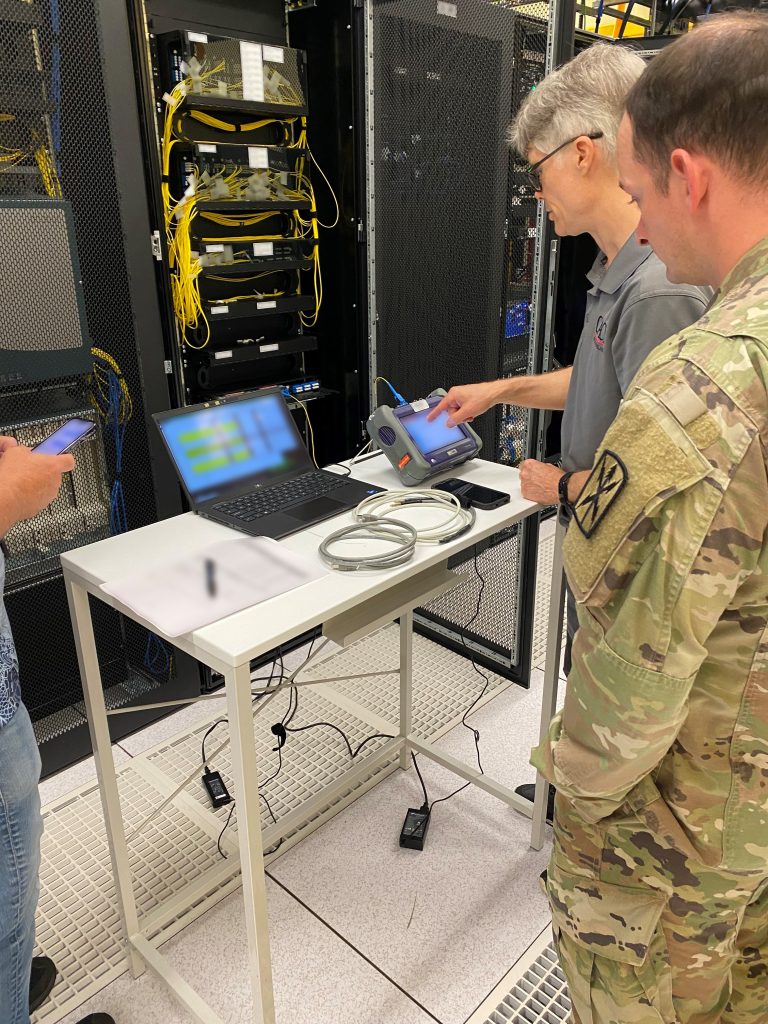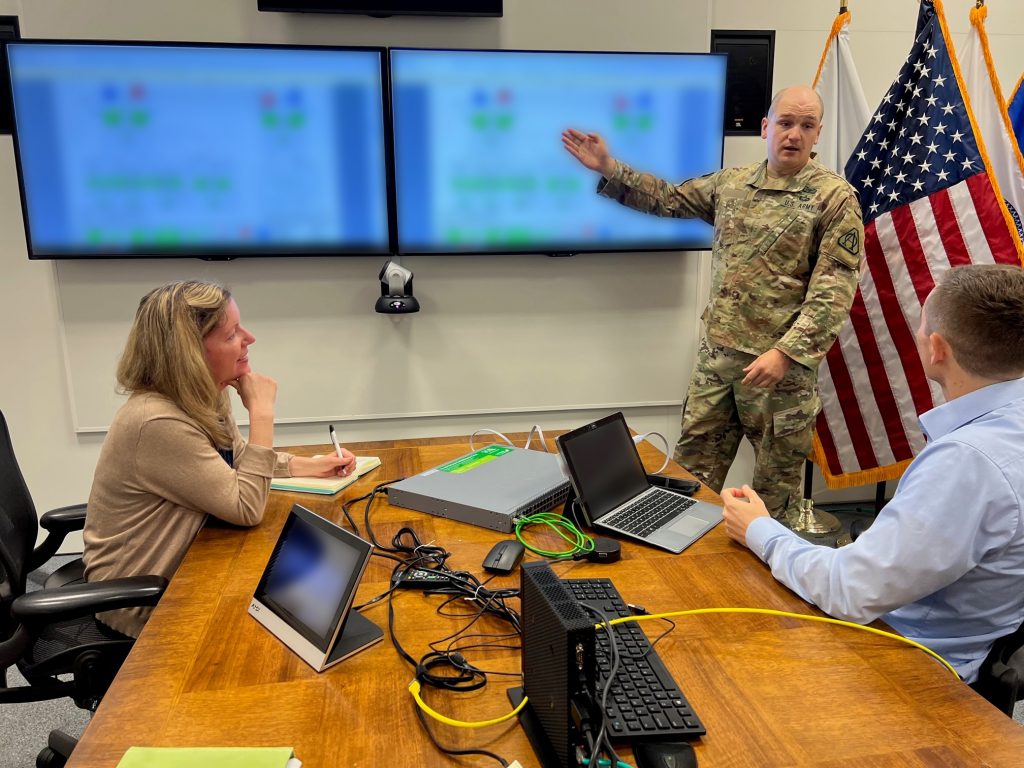
CELEBRATING IN GERMANY: GENM-O members participate in a ribbon cutting at the Sembach Kaserne U.S. Army post in Germany, Aug. 29, 2023. Sembach Kaserne, within the Kaiserslautern district, is the first base within GENM-O’s eight network modernization projects in Europe to complete a network migration. (Photo by Christopher Labatte, GENM-O)
PEO C3T’s Global Enterprise Network Modernization ‒ OCONUS works to make it easy to plug into the unified network from anywhere in the world.
by Justin Creech and Danielle Kress
Atop the Army’s modernization priorities is a unified network that integrates data, speed, flexibility and security to enable commanders and warfighters to communicate effectively and make quick, strategic decisions.
Historically, the Army has leveraged theater-centric networks based on location and the tactical or enterprise nature of the mission. But over the last few years, priority has been given to capabilities that remove boundaries and make it easy to plug into the network from anywhere in the world.
Across Europe and the Pacific, some of these modernization efforts have been led by the Global Enterprise Network Modernization ‒ Outside the Continental United States (OCONUS) Product Manager, referred to as GENM-O, within the Program Executive Office for Command, Control and Communications ‒ Tactical (PEO C3T). It is geared toward increasing speed through technologies like the Global Secret Internet Protocol Router Network (SIPRNet), modernizing voice and video, and upgrading infrastructure across numerous sites to support modernized capability.

TEST MODE: Chief Warrant Officer 2 Stephen Wallace, 516th Signal Brigade senior network technician, and Dan Marcum, a CACI engineer, test circuits during the GENM-O Pacific Theater’s systems acceptance test in Okinawa, Japan, May 12-16, 2023. (Photo by Alexandra Passoff, GENM-O)
‘PLUGGING IN’ TO THE PACIFIC
In Honolulu, Soldiers from the 25th Infantry Division and the 30th Signal Battalion participated in an end-user-device limited user test to help the Army optimize the functionality of Commercial Solutions for Classified (CSfC), across the Pacific region, minus Korea. Global interconnected CSfC allows individual users to access classified information over commercial networks.
“The ability to connect to a wireless or 5G network anywhere in the world is how CSfC helps expand the [Global SIPRNet],” said Albert Chavez, GENM-O Pacific Team senior architect. “If I’m OCONUS and there’s a wireless connection right next to me, I can securely connect and download a file that I need to send a commander in milliseconds, as opposed to how our legacy capabilities functioned.”
Before the fielding of these new end-user devices, Soldiers had to wait for communication infrastructure to be set up to access the classified network. Now, according to Chavez, if there are any internet connections available—commercial or otherwise—Soldiers can connect and continue their work.
Part of the Army’s comprehensive modernization initiative is delivering the SIPRNet worldwide with CSfC as an important part in the Global SIPRNet rollout because of the multiple connectivity options it provides for end users.
“We’ve already increased the [end-user-device] functionality with additional user applications and features, such as audio-video conferencing,” Chavez said.
Across the Pacific in Okinawa, Japan, upgrades have been focused on network flexibility, agility and bandwidth necessary for the Army to execute its mission and maintain dominance over near-peer competitors.
The upgrades began with the implementation of a Multiprotocol Labeling System network that provides instantaneous bandwidth without needing to manually re-cable the connection point from one user to another. The previous system, which used a Synchronous Optical Network, did not offer the same flexibility because of its use of static networks, which contained predetermined pathways for the data to travel to reach a specific end user.
“The best way to describe the [Multiprotocol Labeling System network] is to compare it to a cellphone network,” says Dominic Ribaudo, GENM-O computer engineer. A Synchronous Optical Network “is a bunch of dedicated landlines where the Army must anticipate the maximum lines shared between general users and first responders. If either reaches its capacity, the receiver would get a busy signal. With [the Multiprotocol Labeling System network], the Army can prioritize mission needs and the first responders will never reach capacity.”

NETWORK MIGRATION: Maj. Christopher Biddie, GENM-O assistant product manager, discusses new network architecture for Sembach Kaserne U.S. Army post in Germany with Andrea Zalasky, GENM-O assistant product manager, and Christopher Hyers, GENM-O senior program manager. (Photo by Christopher Labatte, GENM-O)
MISSION-CENTERED INFRASTRUCTURE
Across Europe, GENM-O teamed with its Army stakeholders to execute more than 45 infrastructure and network modernization projects throughout 11 countries to modernize voice, video, data and mission command from afar solutions.
GENM-O delivered telecommunication room improvements, cabling and equipment installation both inside and outside the facilities, heating, ventilation and air conditioning, audio visual, video teleconference, wireless efforts and SIPRNet infrastructure modernization.
In Powidz, Poland, in particular, GENM-O’s infrastructure modernization enhanced connectivity between buildings through the installation of a wireless bridging system in lieu of fiberoptic cable installations.
The wireless antennas and radios that make up the bridging system transmit encrypted Non-classified Internet Protocol Router Network (NIPRNet) data from one network switch to another at extended ranges. These advancements were necessary as many of the buildings contained little to no IT network support capability due to being built during the Cold War.
In Germany, NIPRNet modernization was again prioritized, completing the first wave of migrations moving users off legacy network equipment and onto current technology with improved architecture. The project involved designing a new network architecture and installing new switching infrastructure at the Sembach Kaserne Army post to connect multiple information technology devices like computers and printers on the same network.
Protection against security vulnerabilities is a huge benefit to the new switches, according to Christopher Hyers, GENM-O Europe Team senior project manager, in addition to larger capacity uplinks, reduced latency and increased end user connectivity capability.
“The increased gigabytes improve the amount of data that can be processed and transferred at one time,” said Hyers. “So, the network provides increased capability to transmit voice, video and data at higher rates.” Essentially, the network isn’t as vulnerable to disruptions as it was with the legacy technology.
“Each switch has dual connections, which means if some other network device fails within the architecture, new routes can be created allowing communications to continue,” Hyers said. “It’s a rolling wave of migrations, where all these new users are moved to the new network and have new support. It’s good to be at this milestone point and have this capability going out to our European theater users.”
CONCLUSION
As the network remains one of the Army’s top transformation priorities, GENM-O’s mission also remains vital. Its network modernization efforts will ensure that—through efforts like the Global SIPRNet, voice modernization, software-defined networking, and more—theaters across the world can seamlessly communicate in support of the Army’s mission.
For more information, go to https://peoc3t.army.mil/Organizations/PM-Integrated-Enterprise-Network/Global-Enterprise-Network-Modernization-OCONUS.
JUSTIN CREECH is the public affairs officer for the Global Enterprise Network Modernization – OCONUS program office. He holds a B.A. in communication from George Mason University. His experience includes three years as a staff writer for the Belvoir Eagle and four and a half years as a public affairs broadcast specialist in the U.S. Army Reserve and the Oklahoma Air National Guard.
DANIELLE KRESS is a public communications specialist at PEO C3T. She holds a B.A. in broadcast journalism from Wilmington University.







